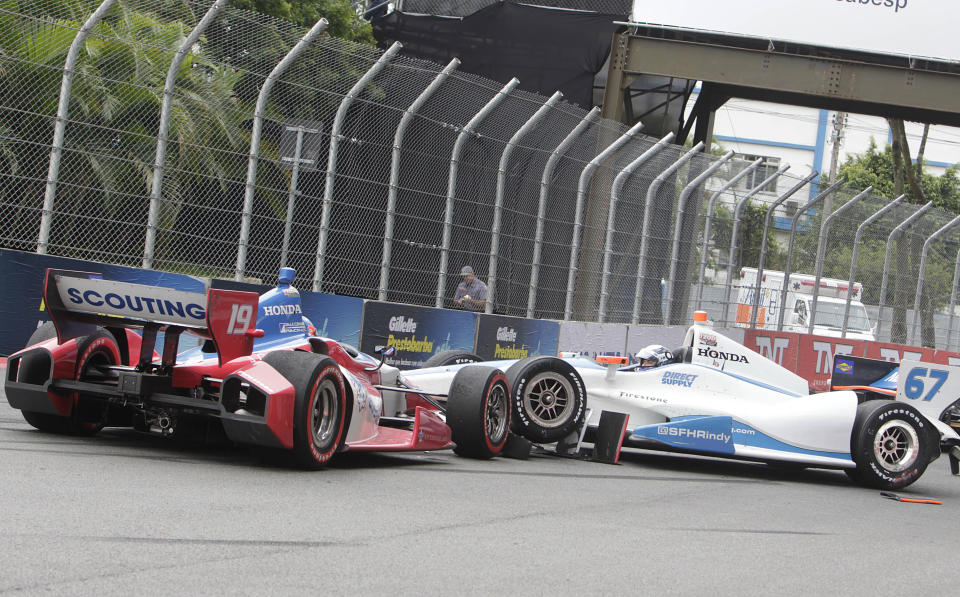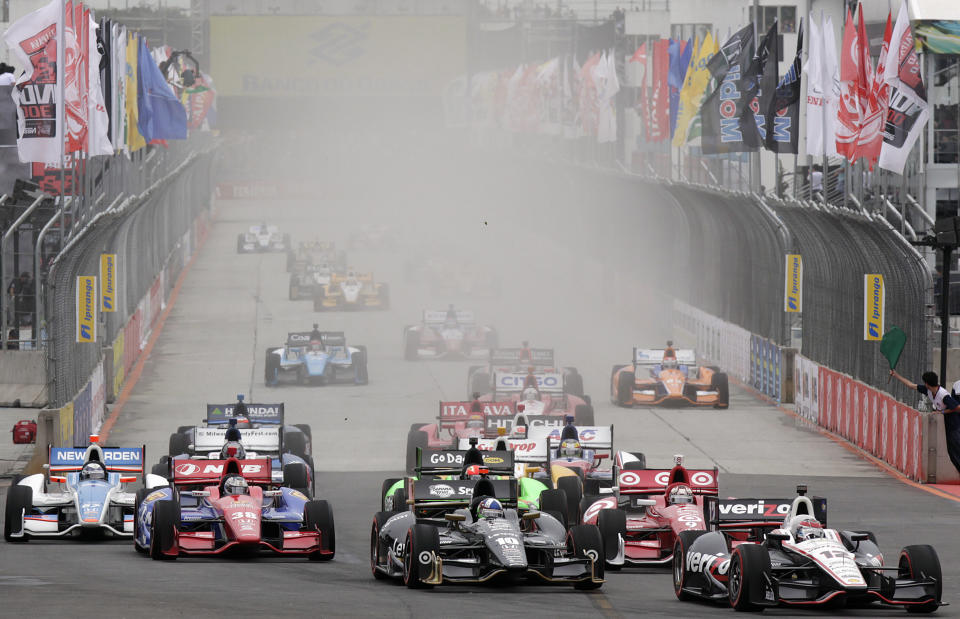Engineer: Dallara was asked to change wheel guard
SAO PAULO (AP) — A Dallara engineer says people within the IndyCar series asked for changes in the rear-wheel guards of the new car in part because of the way they looked, and to keep them from being damaged too often.
An IndyCar official said safety was never undermined, though.
Sam Garrett, the technical leader for the IndyCar project in the United States, told The Associated Press that the bigger rear-wheel guard originally planned by Dallara "possibly" could have prevented Marco Andretti's car from flying over Graham Rahal's in an accident in Long Beach two weeks ago.
Will Phillips, IndyCar's vice president of technology, said aesthetics never came before safety in the new car's design, and that the wheel guard being used is exactly what was initially proposed by Dallara.
Andrea Toso, head of the IndyCar project at Dallara, said the original guards at one point were a little wider, but the changes never affected the car's safety.
Garrett said during the Sao Paulo 300 this weekend that Dallara altered the design of the guards to attend to the demands of "various" people.
"We had originally designed those wheel guards a little bit wider, but for various reasons we have made them a little bit narrower, to make them a little less likely to be damaged," he said. "It was something we were asked to do, by various people who didn't like the way they looked and thought it was more of an aesthetic thing, or that the wider they were the more easily that they would be damaged. So we compromised."
He said that people "within the series" asked them to make the guards a little smaller.
"At one point in the design they were more square and bigger," Garrett said. "Some people didn't like the way they looked. It was a combination of people. Some people complained to the series, the series relayed those complaints to us."
IndyCar this year introduced its first new car in nine years. Part of the safety improvements to the new Dallara were in an effort to keep the cars from launching, although officials from the series and from Dallara say it's virtually impossible to completely prevent cars from flying over others.
Safety was one of the biggest concerns when Dallara created the new car, and it became even more of a priority after Dan Wheldon's death in Las Vegas last year.
Phillips said IndyCar didn't require specific changes to the rear-wheel guards, saying "what's on the car now is what came from Dallara." He said people who are used to more traditional open-wheel racing often complain about the appearance of the new car, but those concerns never affected the design of the safety features.
"The initial rear-wheel guard that we are running now has never been compromised for aesthetics," he told the AP. "It was never changed aesthetically to compromise for safety."
Phillips said the oval cars will have a bigger guard than the ones used on the road and street courses, but the change was made solely because of aerodynamic reasons to improve the car's performance. The first oval race of the season is the Indy 500 on May 27.
"The intention of the rear-wheel guards it to try to prevent wheel-to-wheel contact," he said. "We know that you can never guarantee that wheel-to-wheel contact can't happen. That's the first incident we've had where we would've liked to have done more perhaps, but there are other incidents in the race in Long Beach where there is clear video footage of how good the rear-wheel guards worked."
Toso said IndyCar never came asking Dallara to make the wheel guards smaller. He said it's been a continuing process to make a car that addresses everyone's concerns, but admitted that at one point the idea was to have the guard "a bit wider."
"This is an open-wheel series," he told the AP in a telephone interview. "The fans, the drivers, they need to see the tires. If you enclose totally the cars, it's not an open-wheel series anymore. It's been a process between IndyCar and Dallara to find a right shape, a compromise to protecting the tires and showing the tires."
Garrett said the accident between Andretti and Rahal in Long Beach was very unique because the cars hit at an angle where there was still a little bit of tire exposed outside of the wheel guards, which helped catapult Andretti's car. He said, however, that a wider wheel guard might have kept the tires from touching each other, which could've prevented Andretti's car from going airborne.
"Possibly," he said. "We could make them wider, we could make them stiffer, (but) that would make them heavier. It's all a balance."
Garrett still thinks the current guards are working.
"We've tried to design some features into the car that will reduce the likelihood of a car flying over another one; we don't pretend that we can prevent this from ever happening," he said.
"If you look at all the incidents during the race I would say that the systems that we have in our new car were working most of the time. We had a number of incidents where the car ran behind another one and there were no cars flying. This was the one incident where there was."
Toso said what happened in Long Beach "was unavoidable if the wheel guard was bigger or smaller."
___
Follow Tales Azzoni at http://twitter.com/tazzoni



